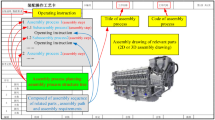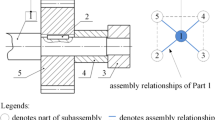Abstract
In this study, we developed a knowledge-based engineering (KBE) system to assist engineers in promptly predicting a near-optimal assembly sequence. A three-stage assembly optimization approach with some heuristic working rules was employed to establish the proposed system. In the first stage, Above Graph and a transforming rule were used to create a correct explosion graph of the assembly models. In the second stage, a three-level relational model graph, with geometric constraints and assembly precedence diagrams, was generated to create a completely relational model graph, an incidence matrix, and a feasible assembly sequence. In the third stage, a robust back-propagation neural network engine was developed and embedded in the Siemens NX system. System users can easily access the volume, weight, and feature number through the Siemens NX system interface, input the related parameters such as contact relationship number and total penalty value, and predict a feasible assembly sequence via a robust engine. Three real-world examples were used to evaluate the feasibility of the KBE system. The results show that the proposed system can facilitate feasible assembly sequences and allow designers to recognize contact relationships, assembly difficulties, and assembly constraints of three-dimensional components in a virtual environment type.
Similar content being viewed by others
References
Mascle C, Zhao HP (2008) Integrating environmental consciousness in product/process development based on life-cycle thinking. Int J Prod Econ 12:5–17
Kuo TC, Huang SH, Zhang HC (2001) Design for manufacture and design for‘X’: concepts, applications, and perspectives. Comput Ind Eng 41:241–260
Kai Y, Basem EH (2003) Design for six sigma: a roadmap for product development. McGraw-Hill, New York
Lotter B (1989) Manufacturing assembly handbook. Butterworths, London
Crowson RD (2006) Assembly processes: finishing, packaging, and automation. Taylor & Francis, New York
De Fazio TL, Whitney DE (1987) Simplified generation of all mechanical assembly sequences. IEEE Trans Robot Autom 3(6):640–658
Bourjault A (1984) Contribution á une approche méthodologique de l’assemblage automatisé: Elaboration automatique des séquences opératoires, Unpublished doctoral dissertation. Faculté des Sciences et des Techniques de l’Université de Franche-Comté, France
Homen de Mello LS, Sanderson AC (1991) Representations of mechanical assembly sequences. IEEE Trans Robot Autom 7(2):211–227
Kroll E (1994) Intelligent assembly planning on triaxial products. Conc Eng Res Appl 1(2):311–319
Lee S (1989) Disassembly planning by subassembly extraction. Proceedings of the third ORSA/TIMS Conference on flexible manufacturing systems, Cambridge, pp 383–388
Prasad B (1997) Concurrent engineering fundamentals: integrated product development. Prentice-Hall, New Jersey
Chen RS, Lu KY, Tai PH (2004) Optimization of assembly plan through a three-stage integrated approach. Int J Comput Appl Technol 19(1):28–38
Tai PH (1997) Feature-based assembly modeling for assembly sequence planning of three-dimensional products. Unpublished master’s thesis, Cranfield University, UK
Chen WC, Tai PH, Deng WJ, Hsieh LF (2008) A three-stage integrated approach for assembly sequence planning using neural networks. Exp Syst Appl 34:1777–1786
Wang L, Keshavarzmanesh S, Feng HY, Buchal RO (2003) Assembly process planning and its future in collaborative manufacturing: a review. Int J Adv Manuf Technol 41:132–144
Henrioud JM, Relange L, Perrard C (2003) Assembly sequences, assembly constraints, precedence graphs. Proceedings of the fifth IEEE symposium on assembly and task planning, France, July 10–11, pp 90–5
Su Q (2009) A hierarchical approach on assembly sequence planning and optimal sequence analyzing. Robot Comput Integr Manuf 25:224–234
Yin ZP, Ding H, Xiong YL (2004) A virtual prototyping approach to generation and evaluation of mechanical assembly sequences. Proc Inst Mech Eng 218:87–102
Dong T, Tong R, Zhang L, Dong J (2007) A knowledge-based approach to assembly sequence planning. Int J Adv Manuf Technol 32:1232–1244
Chen RS, Lu KY, Tai PH (2004) Optimizing assembly planning through a three-stage integrated approach. Int J Prod Econ 88:243–256
Gao ZX, Wong WK, Leung SYS, Fan JT (2009) Intelligent production control decision support system for flexible assembly lines. Exp Syst Appl 36(3):4268–4277
Gao ZX, Wong WK, Leung SYS, Fan JT, Chan SF (2008) A genetic-algorithm-based optimization model for scheduling flexible assembly lines. Int J Adv Manuf Technol 36(1–2):156–168
Wong WK, Leung SYS, Mok PY (2006) Developing a genetic optimization approach to balancing an apparel assembly line. Int J Adv Manuf Technol 28:387–394
Tseng HE, Wang WP, Shih SY (2007) Using memetic algorithms with guided local search to solve assembly sequence planning. Exp Syst Appl 33(2):451–467
Gao L, Qian W, Li X, Wang J (2010) Application of memetic algorithm in assembly sequence planning. Exp Syst Appl 49:1175–1184
Wang JF, Liu JH, Zhong YF (2005) A novel ant colony algorithm for assembly sequence planning. Int J Adv Manuf Technol 25:1137–1143
Marian RM, Luong LHS, Abhary K (2003) Assembly sequence planning and optimisation using genetic algorithms. Appl Soft Comput 2(3):223–253
Tripathi M, Agrawal S, Pandey MK, Shankar R, Tiwari MK (2009) Real world disassembly modeling and sequencing problem: optimization by Algorithm of Self-Guided Ants (ASGA). Robot Comput Integr Manuf 25(2009):483–496
Choi YK, Lee DM, Cho YB (2009) An approach to multi-criteria assembly sequence planning using genetic algorithms. Int J Adv Manuf Technol 42:180–188
Hongbo S, Shuxia L, Degang G, Peng L (2006) Genetic simulated annealing algorithm-based assembly sequence planning. International Technology and Innovation Conference, ITIC 2006 1573–1579
Kulon J, Broomhead P, Mynors DJ (2003) Applying knowledge-based engineering to traditional manufacturing design. Int J Adv Manuf Technol 30:945–951
Lovett PJ, Ingram A, Bancroft (2000) Knowledge-based engineering for SMEs—a methodology. Int J Mater Process Technol 107:384–389
Chen CLP (1990) Neural computation for planning and/or precedence-constraint robot assembly sequences. Proceedings of the International Conference on Neural Networks, San Diego, CA, pp 127–142
Hong DS, Cho HS (1995) A neural network based computational scheme for generating optimized robotic assembly sequences. Eng Appl Artif Intell 8(2):129–145
Sinanoğlu C (2006) A neural predictor to analyze the effects of metal matrix composite structure (6063 Al/SiCp MMC) on journal bearing. Ind Lubr Tribol 58(2):95–109
Chen WC, Hsu YY, Hsieh LF, Tai PH (2010) A systematic optimization approach for assembly sequence planning using Taguchi method, DOE, and BPNN. Exp Syst Appl 37(1):716–726
Sage AP (1990) Concise encyclopedia of information processing in systems and organizations. Pergamon, New York
Haupt RL (2004) Practical genetic algorithms, 2nd edn. Wiley-Interscience, USA
Maier HR, Dandy GC (1998) Understanding the behaviour and optimising the performance of back-propagation neural networks: an empirical study. Environ Model Softw 13:179–191
Liu Y, Liu W, Zhang Y (2001) Inspection of defects in optical fibers based on back-propagation neural networks. Opt Commun 198(4–6):369–378
Yao S, Yan B, Chen B, Zeng Y (2005) An ANN-based element extraction method for automatic mesh generation. Exp Syst Appl 29:193–206
Chen WC, Hsu SW (2007) A neural-network approach for an automatic LED inspection system. Exp Syst Appl 33(3):531–537
Hush DR, Horne BG (1993). Progress in supervised neural networks. IEEE Signal Processing Magazine, January, pp 8–39
Cheng CS, Tseng CA (1995) Neural network in detecting the change of process mean value and variance. J Chin Inst Ind Eng 12(3):215–223
Santos MS, Ludermir B (1999) Using factorial design to optimize neural networks, International Joint Conference on IEEE Neural Networks, Washington, DC, 2, pp 857–861
Boart P (2005) Life cycle simulation support for functional products. M.Sc. thesis, Luleå University of Technology, Sweden
Author information
Authors and Affiliations
Corresponding author
Rights and permissions
About this article
Cite this article
Hsu, YY., Tai, PH., Wang, MW. et al. A knowledge-based engineering system for assembly sequence planning. Int J Adv Manuf Technol 55, 763–782 (2011). https://doi.org/10.1007/s00170-010-3093-5
Received:
Accepted:
Published:
Issue Date:
DOI: https://doi.org/10.1007/s00170-010-3093-5




